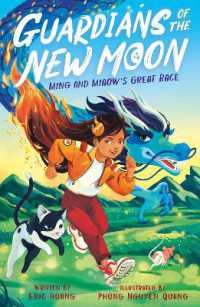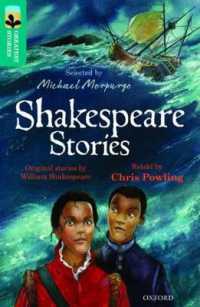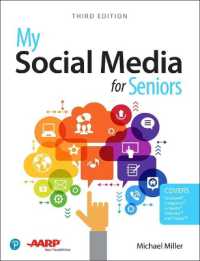Full Description
NoteEnhanced Pearson eText. To order the Enhanced Pearson eText packaged with a bound book, use ISBN 0134057244.A warm and comprehensive child-centered approach to early childhood education Who Am I in the Lives of Children? An Introduction to Early Childhood Education presents a constructivist approach to early childhood education (birth to grade 3) and care programs that is dedicated to the development of the whole child-physical, social, emotional, and intellectual. With its practical orientation; personal voice; appealing photographs, videos, authentic children's classroom work; and engaging stories, it allows readers to visualize effective classroom practices. Aspiring educators are encouraged to learn about each child's strengths, interests, and challenges. This understanding, coupled with contemporary, research-based information, inspires readers to support each child's growth and learning in ways that are in harmony with who they are, rather than according to a predetermined plan. The Enhanced Pearson eText features embedded video and assessments.Improve mastery and retention with the Enhanced Pearson eText*The Enhanced Pearson eText provides a rich, interactive learning environment designed to improve student mastery of content. The Enhanced Pearson eText is:Engaging. The new interactive, multimedia learning features were developed by the authors and other subject-matter experts to deepen and enrich the learning experience. Convenient. Enjoy instant online access from your computer or download the Pearson eText App to read on or offline on your iPad (R) and Android (R) tablet.* Affordable. The Enhanced Pearson eText may be purchased stand-alone or with a loose-leaf version of the text for 40-65% less than a print bound book.*The Enhanced eText features are only available in the Pearson eText format. They are not available in third-party eTexts or downloads.*The Pearson eText App is available on Google Play and in the App Store. It requires Android OS 3.1-4, a 7" or 10" tablet, or iPad iOS 5.0 or later.
Contents
Brief Table of ContentsChapter 1 The TeacherChapter 2 The Field of Early Childhood Education Chapter 3 History of Early Childhood EducationChapter 4 Child DevelopmentChapter 5 Observing and Assessing Young ChildrenChapter 6 Relationships and GuidanceChapter 7 Health, Safety, and Well-BeingChapter 8 The Learning EnvironmentChapter 9 Understanding and Supporting PlayChapter 10 The CurriculumChapter 11 Curriculum PlanningChapter 12 Including All ChildrenChapter 13 Partner-ships with FamiliesChapter 14 Becoming an Early Childhood Professional Detailed Table of ContentsChapter 1 The TeacherThe Work of the Early Childhood EducationThe TasksWorking with FamiliesWorking as Part of a TeamThe Teacher as a PersonQualities of a Good Teacher of Young ChildrenPersonal AttributesPersonal Values and MoralityAttitudes Toward DiversityThe Impact of Life ExperiencesThe Teacher as a ProfessionalSpecialized Knowledge and SkillsProfessional Commitment and BehaviorLegal ResponsibilitiesProfessional Values and EthicsCareers in Early Childhood: Finding Your PathRolesEducational RequirementsStages of Professional DevelopmentFinal ThoughtsChapter 2 The Field of Early Childhood EducationTypes of Programs for Young ChildrenChildren ServedPurposeFacilitiesSponsorship and FundingPrograms for Children from Birth to Age 5Child CarePrograms Whose Primary Purpose is EducationEarly Childhood Family EducationState-Funded Public Prekindergarten ProgramsPrograms for Children from 5 to 8 YearsKindergarten Through Grade 3 Programs: Primary GradesCharter SchoolsHome SchoolsPrograms for Children from Birth to Age Eight Who Have DisabilitiesEarly InterventionPreschool Programs for Children with DisabilitiesPublic School Programs for 5- to 8-Year-Olds with DisabilitiesProgram AccountabilityProgram RegulationEducational StandardsEarly Learning StandardsCommon Core StandardsSchool ReadinessFinal ThoughtsChapter 3 History of Early Childhood EducationThe Origins of Early Childhood EducationAncient Greece and Rome (400 B.C.- A.D. 200)The Middle Ages (500-1450)The Renaissance and The Reformation (1300-1600)The Age of Enlightenment (1700s)The Industrial Revolution (1800s)Educational Movements That Shaped the Field of Early Childhood EducationFroebel and The KindergartenMargaret and Rachel McMillan and the Nursery SchoolJohn Dewey and Progressive EducationContemporary ExamplesThree European ApproachesThe Montessori MethodWaldorf EducationThe Reggio Amelia ApproachCommon Elements of the Three ApproachesChild Care in the United StatesThe Origins of Child Care in the United StatesChild Care in Times of National EmergencyChild Care after World War IIThe Evolution of Early Childhood Education and CareFinal ThoughtsChapter 4 Child DevelopmentWhy Study Child Development?Principles of Child DevelopmentThe Child Develops as a WholeDevelopment Follows Predictable PatternsRates of Development VaryDevelopment is Influenced by Maturation and ExperienceDevelopment Proceeds from Top Down and from Center OutwardCulture Affects DevelopmentApplying Principles to PracticeHeredity and EnvironmentThe Biological Basis of DevelopmentThe Impact of EnvironmentTheories of DevelopmentArnold Gesell and Maturational TheoryJean Piaget and Constructivist TheoryLaurence Kohlberg and Moral Development TheoryLev Vygotsky and Sociocultural TheoryUrie Bronfenbrenner and Ecological TheoryErik Erikson and Psychosocial TheoryB. F. Skinner and Behaviorist TheoryHoward Gardner and Multiple Intelligences TheoryAbraham Maslow and Self-Actualization TheoryDevelopment of the Whole ChildDomains of DevelopmentPeriods of DevelopmentUnderstanding Infants' DevelopmentUnderstanding Toddlers' DevelopmentUnderstanding Preschoolers'/Kindergartners' DevelopmentUnderstanding Young School-Age Children's DevelopmentFinal ThoughtsChapter 5 Observing and Assessing Young ChildrenThe Purpose of AssessmentAuthentic AssessmentLearning to ObserveBeyond Observation: Other Authentic Assessment MethodsPortfoliosSharing Authentic AssessmentStandardized AssessmentKinds of Standardized Assessment InstrumentsConcerns with Standardized TestingFinal ThoughtsChapter 6 Relationships and GuidanceThe Foundations of Child GuidanceRelationshipsUnderstanding and Honoring DifferencesKnowledge of DevelopmentGoals for GuidanceLong-Term GoalsShort-Term GoalsCommunication: A Powerful Guidance ToolRespectful and Authentic SpeechListeningRespondingGuiding GroupsUse AuthorityCreate Guidelines for Behavior Anticipate ProblemsOrchestrate TransitionsManage Large Group TimesClassroom ClimateCreate a Supportive EnvironmentEncourage FriendshipsModel and Teach Respect and FairnessTeach Children to Deal with ConflictManaging Inappropriate BehaviorsReframing Misbehavior as "Mistaken Behavior"Strategies for Dealing with Mistaken BehaviorBullyingChallenging BehaviorsFinal ThoughtsChapter 7 Health, Safety, and Well-BeingWhy Study Safety, Health, and Well-Being?Safe Places for ChildrenWhat Is Safe? Developmental Differences and SafetySafe Outdoor EnvironmentsVehicle and Trip SafetySafe Indoor EnvironmentsPractices That Promote SafetyHelping Children Learn to Be SafeProtecting Children from Abuse and NeglectHealthy Places for Young ChildrenUnderstand How Illness SpreadsFollow Healthy RoutinesWork with a Health Care ProfessionalKnow About Conditions That Affect HealthHelp Children Learn to be HealthyPromote Physical Activity and MovementEncourage Healthy Food ChoicesMake Health a Part of the CurriculumUse Personal Care Routines as Teaching OpportunitiesWell-BeingThe Importance of TouchGood Transitions Support Well-BeingSupporting Children During Times of CrisisFinal ThoughtsChapter 8 The Learning EnvironmentThe Indoor Learning EnvironmentSpaceEquipment and MaterialsMaking the Indoor Environment WorkThe Outdoor Learning EnvironmentOutdoor Activity ZonesAn Outdoor Playscape for Infants and ToddlersUsing the Outdoor EnvironmentDifferent Children - Different PlacesInfant-Toddler Environments: A Place Like HomePreschool and Kindergarten Classrooms: A Child's PlacePrimary Classrooms: A Place Called SchoolIncluding Children with DisabilitiesTimeThe Daily ScheduleFinal ThoughtsChapter 9 Understanding and Supporting PlayUnderstanding PlayCharacteristics of PlayKinds of PlayWhy Children PlayTheories of PlayStages of PlayThe Role of Play in DevelopmentThe Role of Play in Physical Development The Role of Play in Emotional DevelopmentThe Role of Play in Social DevelopmentThe Role of Play in Cognitive DevelopmentThe Role of Play in Integrating DevelopmentThe Special Role of Outdoor PlayExplaining PlayFacilitating PlaySupportive AttitudesSupportive RolesIssues in PlayDiversity and PlayGender-Stereotyped PlayViolent Dramatic PlayRough-and-Tumble Play Exclusion-You Can't Say You Can't PlayShrinking Opportunities for PlayFinal ThoughtsChapter 10 The CurriculumWhat is Curriculum?Where Does Curriculum Come From?How Young Children LearnCurriculum in Early Childhood EducationHow Early Childhood Teachers TeachThe Physical Development CurriculumGross Motor CurriculumFine Motor Curriculum Sensory Development CurriculumThe Communication CurriculumLanguage CurriculumLiteracy CurriculumLiterature CurriculumThe Creative-Arts CurriculumVisual Art CurriculumMusic CurriculumCreative Movement CurriculumAesthetics CurriculumThe Inquiry CurriculumMath CurriculumScience CurriculumSocial Studies CurriculumFinal ThoughtsChapter 11 Curriculum PlanningWhy Teachers PlanWhat Influences PlanningWhat You TeachHow Curriculum Is OrganizedWhat Goes in a PlanBasing Plans on What You ObserveTeaching Methods or StrategiesWriting PlansActivity or Lesson PlansWeekly PlansPlanning an Integrated StudyFinal ThoughtsChapter 12 Including All ChildrenDual Language LearnersWorking with Dual Language Learners in ECE ProgramsChildren with DisabilitiesTerminologyLaws Governing Services to Children with DisabilitiesPrograms for Children from Birth Through Age 2Programs for Children 3 to 5 Years of AgePrograms for Children 5 to 8 Years of AgeIdentification of DisabilitiesInclusionCharacteristics of Young Children with DisabilitiesChildren with other Special NeedsChildren with Special Gifts and TalentsChildren Who Have Been Abused or NeglectedChildren with Acute or Chronic Health ConditionsWorking with Families of Children with DisabilitiesFinal ThoughtsChapter 13 Partner-ships with FamiliesUnderstanding Families/Understanding YourselfResponsibilities of Today's FamiliesDiverse FamiliesFamily Systems TheoryUnderstanding YourselfBuilding Relationships with FamiliesEstablishing Relationships with FamiliesStrong BeginningsHome VisitsCommunicatingConfidentialityEngaging Families in Your ProgramClassroom InvolvementProgram InvolvementFamily EducationSupporting FamiliesHelping in Times of StressPreventing and Reporting Child Abuse and NeglectSupporting Families of Children with DisabilitiesFinal ThoughtsChapter 14 Becoming an Early Childhood ProfessionalPart I: Current Realities in Early Childhood EducationA Changing SocietyContinuing IssuesDevelopments in Early Childhood PolicyPart II: Becoming a ProfessionalKnowledge and SkillProfessional BehaviorPersonal CharacteristicsChoose Your PathTake Care of Yourself








